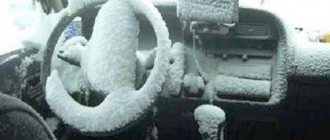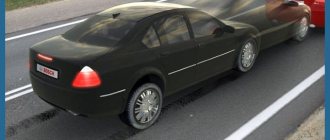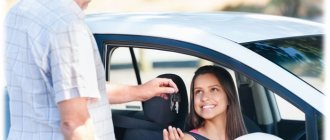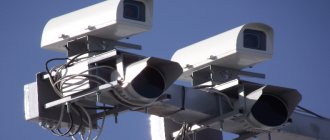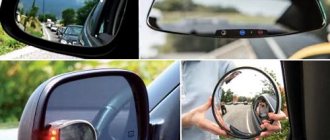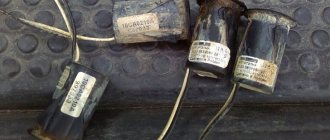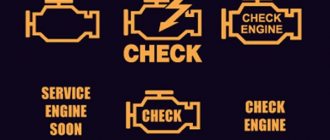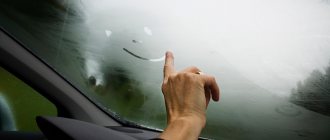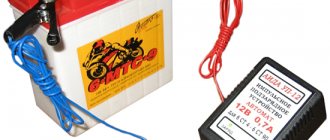How to understand the dimensions of a car - beginner mistakes
The problem of car feel is especially acute for drivers without experience. Beginners who have recently received a driver's license complain: they don't feel the size of the car. In the first year of their practice, motorists are faced with problems of parking and maneuvering in narrow areas: it is difficult for them to turn around in a small area, in limited conditions, among many other obstacles.
When I got behind the wheel for the first time, it seemed to me that I was sitting in the center, and to the right and left of me there was the same distance to the wheels. Until now, after 10 years of driving experience, probably, like many drivers, I feel better the left dimensions - along the driver's seat.
As you can see, first of all you should understand that there is a greater distance to the right wheel than to the left.
The second mistake beginners make is trying to see what is in front of the bumper, looking over the hood. For this reason, many novice drivers move the driver's seat closer to the windshield, resting against the steering wheel. Should not be doing that. The driver needs to look at the road, and not at the wheels. You will be able to feel the size of the car when you gain sufficient skill.
And one more piece of advice – the main thing is to learn how to use mirrors. In the mirror, it seems that neighboring cars are further away than in reality. You think that the car behind you is still far away, since it looks quite small in the mirror, but in reality it is just an optical illusion.
IT IS IMPORTANT TO KNOW. Side and rearview mirrors have a blind spot
A car's blind spot is the space around the car that is not reflected in the mirrors. The driver may not be able to see oncoming vehicles from his seat. Therefore, it is worth remembering that before starting a maneuver, you need to first look in the mirrors several times, making sure that it is safe.
How to learn to drive a car: starting and braking correctly
And so, you got behind the wheel. Let us repeat that you should be comfortable and comfortable in the seat, and your hands on the steering wheel should be bent.
Let's start driving the car
- Focus on the pedals - there are three of them. On the left is the clutch, in the middle is the brake and the last pedal on the right is the gas. It is important to remember one rule: the left foot always depresses the clutch, and the right foot works in turn on the two remaining pedals.
- In modern models, there are often only two pedals, because there is no need to adjust the speed. Therefore there is no clutch. But we'll come back to this a little later. For now, we propose to analyze a complicated variation.
- Of course, the car needs to be started. To do this, turn the ignition key to the ACC . After which, you need to turn it to ON . At first, you can even keep a report - after about 8-10 seconds, turn the key until it says “Start” .
- At this stage, the car should show signs of life, that is, start. Feel free to release the key. And don’t be afraid - it returns to the ON .
Important: If you want to turn off the car, then simply turn the key to its original position. That is, at the ACC mark.
The standard picture under the feet of most drivers - remember their position
- It's time to try to move out. Of course, the first thing you need to do is start the car. But keep in mind that you need to start driving only from first gear. Otherwise there will be a sharp jerk, which is bad for the motor.
- But don’t be afraid to press the clutch, so press it all the way with your left foot. Set the lever to first speed. After this, lightly apply gas with your right foot.
- The handbrake is still in first gear, so you shouldn’t squeeze the gas all the way. Try to feel the engine. As a rule, the tachometer will already show 2000 rpm, and the car will begin to move forward.
- Now you need to put your right foot on the central pedal, that is, on the brake. At the same time, press the button on the brake lever and lower it down.
- Now put your right foot back on the gas so as not to lose speed.
- And now you release the clutch very smoothly. Remember - there should be no sudden or strong movements in this regard.
Important: You can shift to a higher gear only if the tachometer shows a mark above 3 thousand revolutions. True, not every car has them. But most modern models are equipped with them.
The car can start moving downhill
An important point is the beginner’s ability to move downhill. If you make a mistake, the car will stall and may roll down. The story will end, at best, in a fright. Let's talk about the most popular way of driving, which is well known to drivers.
- Start with the handbrake - it must be on. This maneuver will prevent the car from rolling back.
- Remember that your left foot works with the clutch. Therefore, gently press it and set the starting position.
- Smoothly releasing the clutch, you also smoothly depress the gas pedal. Your car starts moving forward.
- The gas must be kept in a stable position at no more than 2.5 thousand vol.
- Now smoothly remove the car from the handbrake, remove your foot from the clutch and, squeezing the gas, add speed.
With a handbrake - this is the correct and basic method of starting downhill
Important: But experienced drivers use a slightly different technique - “foot drop”. That is, the left foot presses the clutch, and the right foot is on the brake. To start moving, smoothly release the clutch. And attention - as soon as the car starts to move, immediately move your foot to the “gas” position. But the engine should not drop below 3 thousand revolutions in such a situation.
Mastery of braking or how to learn to stop on time?
- The braking process on an automatic transmission is elementary. Just use your right foot to gently press the brake, first reducing the speed. And then you stop smoothly.
- On the mechanics box, the algorithm of actions is somewhat wider. To begin, take your right foot off the gas pedal. With your left foot, depress the clutch and, at the same time, press the brake until the movement comes to a complete stop.
- Now exhale and release the pedals. Please note that the brake must be released smoothly so that the car does not suddenly stall.
- After the car has stopped safely and in the right place, do not forget to switch it to neutral speed and put the handbrake on.
Change lane training
How to learn how to putty car body parts with your own hands.
Repeating the “parking in a confined space” exercise will help you figure out how to feel the dimensions of the car. Plastic tall objects come to the rescue. On an empty site, they imitate the lines of the curb and the dimensions of standing cars, between which you will have to squeeze. The best option, of course, is to actually drive into a courtyard or parking lot near a hypermarket. But for beginners it is better to practice in desert places first.
For example, let's take the Tiida Nissan model. The dimensions of the car are the same as those of most popular sedans. It is not recommended to choose smaller vehicles for training. The selected one goes to all classic garages, helping in the future to quickly evaluate sufficient quantities from the car's interior.
Training should be carried out at different times of the day. At night, distances begin to be perceived differently due to the headlights. On a bright day, fewer accidents occur, according to statistics. Even professionals make mistakes due to fatigue or after a hectic evening. Similarly, it is worth training constantly so as not to waste money on expensive repairs in the future.
How to feel the dimensions of a car
How to learn to ride a motorcycle
Don't be lazy to spend time on practical exercises. And you can practice in the following way: we take light boxes and build from them something similar to a gate, after which we try to drive through them. You need to devote several hours to this exercise, and if you cope with this task easily, we complicate it, that is, we reduce the distance between the boxes and increase the speed.
Approximately the same principle can be used - using boxes we designate the space into which we will need to move.
You can learn to feel the dimensions of your car in other ways. We draw a line on the asphalt, and then try to drive up close to it, but at the same time you should not touch it with your wheels.
And if you see that you cannot complete this exercise, then you can return to the task with boxes again. Also remember, this exercise will need to be performed until you learn to correctly determine the distance between your vehicle and such a stop line. This task is intended not only for the front wheels, but also for the rear ones.
In addition to these, there are other equally effective exercises. We take chalk and draw lines from the front wheels of the car 7 - 8 meters in front of them. At the same time, try to keep them as parallel to each other as possible. Next, we sit behind the wheel of a car, look for some stationary object that is constantly in front of your eyes (a protrusion on the dashboard can be suitable as such an object), and connect this object with the line that we drew from the right wheel, then along In the same diagram we mark the position of the left wheel. Thanks to this exercise, we will be able to feel the dimensions of our car. We drive away from these lines a little back, then drive your wheels onto them again.
If you combine all the above exercises, then I think you will get used to the dimensions of your car very quickly.
In order to confidently drive a car, you need to feel its dimensions. Its dimensions mean the main dimensions: length, width and height
But knowing specific measurements is not enough; it is important, while inside the car, to understand the real distances from the vehicle body to external obstacles
We will tell you how to feel the car and learn how to drive through even the narrowest places. After all, all vehicles differ in their size, so even if an experienced driver gets behind the wheel of a new vehicle, he will need time to determine the size of the car. Not to mention beginners who find it difficult to understand their place on the road.
Let's try to figure out how to feel a car, what main problems inexperienced drivers face, and how to develop a spatial orientation scheme.
How to learn to navigate the city?
Someone manages to get lost by entering an unfamiliar part of their native (forest) area. And being alone in a foreign city is scary to imagine!
Without going into the reasons for “topographic cretinism,” let’s assume that you “simply haven’t mastered” terrain orientation. So, you need to take it and learn! The main thing is to understand: we learn to navigate not in our own city/region, but “in the city in general.”
Every city was built by people. This means that it is arranged logically. If we understand this logic, we will understand the city.
First of all, let's take a map and look at the city from the outside. Let us evaluate its general structure.
There are two main city planning schemes: radial-ring and linear.
The “radial” plan resembles a target with “rings” of roads around a clearly visible center and streets diverging radially from the center.
With a linear scheme, the city is “divided” by a grid of roads into conditional, ordered cells-blocks. For convenience, roads running “along” and “across” such a city may have different names. For example, avenues and streets; street and avenue. Or in coastal cities - streets parallel to the shore and alleys perpendicular to them.
In most cities, the center stands out - most often the place where the city began to be built. In “ring” cities, the center is clearly visible on the map. cities is not always so obvious.
Paris aerial view with Eiffel Tower Photo: Depositphotos
In the center there are usually historical or simply older buildings and the city administration, often there are railway and bus stations somewhere nearby.
Houses are usually numbered from the center to the outskirts.
If you stand along the street, the house numbers on the left will be odd on the right - even. It’s easy to remember: we write from left to right, and we count in the same way at home. This is in Moscow. In St. Petersburg it’s the other way around. In Russia, both schemes are used, but more often the first, Moscow one.
In cities located along rivers, houses on streets perpendicular to the embankment are counted from the embankment, on parallel streets - along the river.
Sometimes it is recommended to navigate by tram lines. It seems that new tram tracks have not been laid in Russia for a long time. This means that trams only run in the old part of the city. Unfortunately, this rule does not work everywhere. Cities differ in both layout and pace of development. And I would be careful not to speak for all of Russia. In Moscow, for example, trams go almost to the outskirts, and trolleybuses also go to the suburbs.
Sometimes it is convenient to navigate by the cardinal points. Yes, yes, in the city! For example, in Moscow, divided into Northern, Southern, etc. districts.
To determine the cardinal directions, you can use natural landmarks. For example, mosses and lichens often settle on the northern walls of buildings, near drainpipes. The tree fungus in the city, as in the forest, grows on the north side of the tree trunk. On the sunny side of houses, paint fades faster... But in cities near large bodies of water, the finish wears out faster on the walls on the shore side.
For those who are embarrassed to look at the peeling paint, there are larger landmarks.
City of Yaroslavl Photo: Depositphotos
The apses of Orthodox churches are always in the east, the entrances to the temple and bell towers are in the west. The lower end of the inclined crossbar is in the south. It is widely believed that the altar of a Catholic church faces, on the contrary, to the west. In reality, Catholic churches are not so strictly oriented, and there are many more Orthodox churches in Russian cities.
Is there a temple nearby? In Russia? Strange! Well, there will definitely be satellite dishes. In the northern hemisphere, they are oriented south, towards the geostationary satellite.
But the main tool of a visitor is, of course, a map. Getting to know the city always begins with her, and better - before arriving in a foreign city.
Evaluate the overall structure and urban planning scheme. Find places that interest you: for example, a train station, a hotel, an embankment, a beach, museums... Build possible routes to travel around the city. Even if the actual routes differ, you will understand and remember a lot while working with the map. Be sure to find the city center. If there is no historical, then administrative. It doesn't matter if you don't need it - it's a wonderful landmark that everyone knows.
The monument is a good landmark in the city Photo: Depositphotos
Mark other landmarks: monuments, museums, temples, squares, large institutions, large shops... Things that are easy to notice when you are nearby. Something that “everyone knows” and will show you the way - for example, the city council or the only theater in the city.
It’s very good if there are landmarks that dominate the area and are visible from anywhere in the city: a mountain, a high-rise building, a television tower. They are convenient to navigate while moving around the city.
Of course, if you find yourself in a foreign city suddenly and due to an emergency, you will not have time to explore the area. And here it is better to rely on the navigator.
Unfortunately, more and more people tend to rely on it always, without even trying to remember the route. Although the ability to navigate is a natural function of the brain. And everything that is not used degrades and is lost as unnecessary. It’s one thing if in city life we can do without a navigator, using it for convenience. And it’s completely different when it serves as crutches, compensating for the inability to navigate independently.
Tags: orientation, terrain orientation, city life, foreign city, city layout, cardinal directions, navigate
How to feel the dimensions of a car when entering a garage
Latest reviews from Kia Rio car owners
A very difficult task for a beginner is entering a garage. Therefore, in order to feel the dimensions of the car, you must initially enter backwards, guided by the side mirrors, so you will feel the side dimensions.
When you learn to feel the side dimensions, you can drive into the garage from the front. But now you need to feel the distance from the front bumper to the wall. There is a trick for this. It is necessary to tie a rubber ball to the ceiling on a rope, when entering the garage and touching the ball to the windshield, this will be a signal to you that you have driven in as expected.
Rear view mirrors help control the distance between a wall or other object and the rear edge of the car. It is necessary that they are configured correctly. Ideally, you need to see the rear wheels in the mirrors in order to navigate by them.
Be sure to look in your side mirrors when you need to change lanes. Look in the side mirror, if the neighboring car fits completely, then you can change lanes, but if at least part of the car is not noticeable, then when adjusting you can hit it.
Electronic assistants such as parking sensors and a camera will help you navigate and feel the dimensions of the car much faster.
How to learn to park in reverse
In fact, performing this action is not as difficult as it sounds, you just need to know the rules and develop experience skills.
The most unpleasant thing that can happen is the possibility of hitting a car standing next to you, not feeling well the dimensions of your car. To prevent this from happening in any case, beginners are given basic recommendations. You need to start navigating through all the mirrors, since it is extremely difficult to fully see the situation happening behind the car. When getting behind the wheel, first adjust the side mirrors; they should cover the rear dimensions of your car. The rest should show you the entire view from behind, by pointing them correctly, you don’t have to touch them anymore. The mirror that is located in the center of the cabin needs to be adjusted to the visibility of the rear window, and not your beautiful eyes. Here, as you might guess, female representatives sin, worrying more about their appearance than about safe driving. The next recommendation is that you should not rely solely on the mirror guide. The driver, on top of this, adds a body turn over his right shoulder, lightly holding onto the passenger seat, looking out the rear windshield. Later, as you gain experience, you can abandon such an action.
How to learn to feel a car
A few simple exercises will help you learn how to feel the dimensions of a car. Novice drivers should practice spatial orientation skills on a closed race track. It is for this purpose that instructors separate small areas with flags and force students to drive into a conditional box. We suggest watching a video about how to learn to sense dimensions, and then complete several lessons.
To get a consultation
Lesson 1. Visualization
Mentally draw the position of your car relative to the walls of the box, get out of the vehicle and compare the picture presented with the real one. As a rule, it seems to beginners that the edges of the car are much closer to the walls of a conventional garage than they actually are.
Lesson 2. Beacons
Install an antenna at the extreme point of the hood; it will help you understand where the car body ends. At any time you can stop the car, get out of the car and see how close the obstacle is. After this, it will become clear how to do it correctly in a car, how to evaluate the distance and your own dimensions.
Lesson 3. Marking lines
If you are a beginner, to get a feel for the car, mark six lines on the asphalt with chalk or spray paint that:
- cross the front and rear wheels;
- continue the left and right axes;
- outline the rear and front bumpers.
The intersection points of the wheels with the front dashboard can be marked with colored paper or tape on the windshield. The marks will give an idea of the expected trajectory of movement. Thus, you will learn to determine the place on the road along which the car’s wheels will pass. Over time, the tags will no longer be needed; a chain of reactions will be developed in the brain.
Similarly, you can mark the intersection lines of the front and rear bumpers, front and rear wheels. The markings will make it easier to determine and feel the size and trajectory of the car.
Lesson 4. Getting hit by wheels
Place a small piece of cardboard on the road and deliberately try to run over it with each wheel in turn. This exercise will help you develop your sense of wheel line. Practice not only moving forward, but also reversing.
Lesson 5. Snake
Place barriers on the roadway and try to go around the obstacles without hitting them. Lighthouses can be marked with flags, cones, or ordinary plastic bottles.
Try to drive as close to the beacons as possible. Start with simple exercises, and over time make the tasks more difficult for yourself: place the flags closer together and try to guide the car closely between obstacles; "eight" and "snake".
The main advice on how to get used to the dimensions of the car is to practice as much as possible. You can also watch the video, which will help you get acquainted more clearly https://www.youtube.com/watch?v=l4EiBC8tgP8. Ask an experienced driver or instructor for additional training with you on the site.
Skills are acquired through driving. You will learn to intuitively sense the correct distance to obstacles with high accuracy. With experience, you will understand how to navigate the mirrors in the car, how to feel the car.
To get a consultation
How to learn to drive a car: learning to regulate speed
If your car is manual, then you need to practice the skills of switching it correctly. Over time, you will switch gears without thinking. Well, for now we need to learn.
Changing the first position upward to the second
Almost immediately after you hit the road and everything is going according to plan, it’s time to change gears. After all, you won’t go far at first speed. Moreover, the engine wears out, and fuel is consumed ungodly.
- The first gear is intended to start moving and that’s all - you need to memorize this by heart.
- To shift, release the gas and press the clutch. At the same time, move the gearbox lever to the second gear position.
- Loosen the clutch, press the gas and continue driving. By the way, it is not necessary to keep your foot on the clutch all the time; in this situation, it is entitled to a well-deserved rest. But the right leg should not lose vigilance, because it regulates the speed of the car.
- The gearbox was once a four-speed, but now you can more often find a five-speed manual. But in new car models there are even six-speed gearboxes. But the switching procedure is the same for all types.
Nowadays you won’t surprise anyone with the fifth or sixth speed on a manual.
Let’s go further up, starting with the third speed
The algorithm of actions is basically similar.
- The car continues to move and has already accelerated to 40 km/h. Now go into third gear.
- If the speed reaches 60 km/h, select the fourth position.
- The gauge needle shows 80 km - it’s time for fifth gear.
Important: Don’t forget - you can rely on the tachometer indicators. Driving at lightning speed is dangerous even for experienced drivers, so don't get carried away by driving too fast. Moreover, never forget what area you are in. Remember - fifth speed and higher are designed for driving outside the city, where there are no pedestrians, and for a straight road.
How to reduce speed?
This is an important action, which can often even act as insurance for your life and other people. The most important thing is no sudden or assertive movements. Do everything smoothly!
- Place your foot on the middle pedal and apply gentle pressure. Simultaneously with the gradual braking of the machine, switch the speed position in a decreasing order.
- For example, from position 4 you begin the transition only after reaching 2500 rpm on the display. You release the clutch smoothly, but press the gas pedal to maintain speed.
Almost professional maneuvers: how to reverse?
This skill of your car will definitely come in handy. They turn around backwards, drive into the garage or park. We'll tell you in detail how to make the car go backwards.
- Reverse gear is only engaged when the car is stationary. And when it comes to a complete stop. The left foot, as always, leads. Depress the left pedal while shifting into reverse.
- Modern brands are equipped with a certain ring that is located on the gearshift lever. It must be pulled up.
- Then smoothly release the clutch, but do not forget to lock the gas at the 2500 rpm limit.
- The car moves backwards. In this case, the driver needs to navigate by the mirrors. If an on-board computer is installed in the car, the cameras display the rear view image on the monitor screen, so it is easier to navigate.
Always be careful when reversing.
An automatic transmission will simplify the task for novice drivers.
An automatic transmission will make mastering the car much easier for those drivers who find it difficult to change gears with a manual transmission.
- The main purpose of such a box is driving around the city. Where traffic is busy with a large number of people, crossings and traffic lights, this is an ideal option.
- After all, your hand will never get tired of pulling the lever, since the automatic transmission will do everything itself.
- These cars have two pedals - gas and brake. As soon as you move, the automatic transmission itself will figure out which gear to engage.
- Even more - it itself increases or decreases the speed level. The only thing you change is moving forward or backward.
Problems with perception
The dimensions of trucks are not easy to understand even for experienced drivers. But there are some tricks that allow both beginners and long-distance drivers to perceive the distances to neighboring cars in more detail. To assess the reach of the hood, extend it as far as possible towards the steering wheel. But there are cars where even in this position the nose of the car is not visible. This is where decorative elements on the hood come to the rescue: flags, an antenna, a figurine.
When modernizing a car, they try to install decorative elements on the very edge of the hood. After this innovation, there will be no problems with parking in front. Rearward maneuvers are made easier by fortunately their cost is already low. Models from China will cost several hundred rubles, installation is simple, and you can do it yourself or give the service half of the cost of the gadget for installation.
To improve visibility, many drivers stick convex round mirrors on top of the standard ones. Replace the mirror in the cabin with a viewing one. They install a similar one above the trunk glass in station wagons and minivans. You can use a rear view camera if technically possible.
An easy way to park safely is to have a friend help you. The passenger can get out and manage the process.
What is a manual transmission?
To make it clearer, a manual transmission is a type of transmission that features manual gear shifting . In simple terms, the driver must change gears himself depending on road conditions. As a rule, manual transmissions use 4 or 5 speeds, as well as neutral and reverse gears. Before you start moving, you need to pay attention to the top of the lever to know where the desired speed is located.
Any manual transmission has a clutch, which is controlled by a third pedal. It is necessary to break the connection between the engine and the transmission, because it is in this state that the speed can be changed smoothly without danger to the gearbox. When turning on any stage, you must always press this pedal all the way.
Many drivers have the habit of “driving on the clutch”, thinking that there is nothing wrong with it . In fact, they lose control of the car, as it prevents them from slowing down or accelerating, and also has a detrimental effect on the release bearing, which quickly shortens its lifespan.
There are a number of nuances that you need to know.
- Firstly, this is the first speed - it is needed in order to get going, go through a difficult section of the road or climb a steep slope . All other gears are necessary for movement.
- Secondly, it is reverse speed, which helps us turn around . The operating range of this speed is very large and allows you to accelerate even faster than the first one. However, no mechanic can withstand prolonged work when moving in reverse, so you need to use it as little as possible.
Action plan
The first rule of an experienced driver: “If you have doubts due to lack of visibility or due to poor visibility, poor condition, then you need to stop and not be lazy to go outside and look.” Intuitively, while driving, the desire often comes to wait a few seconds and check what is overboard.
This rule must always be followed during any type of maneuver. This way, the highest level of aerobatics is achieved, the safety of your car and the health of passengers. Even when driving through a green light right away, you should once again make sure that traffic is safe by turning your head left and right. So when parking, you should constantly monitor three viewpoints at once. At any second, a restless baby could sit under your bumper in the yard.
In order to park confidently, change lanes and successfully avoid various obstacles on the road, you need to be well oriented in space, feeling the dimensions of your car. This skill comes with experience, but there are some exercises and ways to speed up the “process of getting used to” the car a little. They will be useful for both beginners and experienced drivers who have switched to a new vehicle.
Some drivers manage to learn to feel the dimensions of new cars in the shortest possible time. Others, even those who have driving experience in a particular car, are not always able to confidently estimate distances when driving. Only constant training and regular driving practice will help you get used to the dimensions of any car.
The rapidly increasing pace of life of modern man has naturally led to the fact that the number of cars on modern roads is increasing every day. Every day only new drivers take them out. Your own car is an indispensable assistant, an extremely comfortable and maneuverable means of transportation that allows you to solve many problems.
Moving around the city very often occurs along narrow streets or in dense traffic. High traffic density in a limited space naturally forces drivers to organically feel the dimensions of cars in order to eliminate the possibility of an accident. This is especially necessary for an inexperienced driver who finds it difficult to quickly navigate a traffic situation.
How can beginners learn to drive in unpredictable situations on the road?
This point can be called the most important. Learning to drive a car is not as difficult as learning to control yourself in extreme situations. It’s not always possible to think soberly and pull yourself together “on your own two feet,” but there’s a whole machine here. And add passengers and pedestrians walking nearby, and the level of responsibility evokes even more fear. Therefore, we suggest that you analyze in order all the incidental situations that can, and at least once, happen to a new and even experienced driver.
We control the car during bad weather conditions
Driving in good weather or on a clear summer day is one thing. And when the weather is capricious or it snows, rains, or maybe even worse, ice, then these are additional obstacles to driving a car.
- Don't forget simple safety rules. In winter, for example, the tires must be appropriate. After all, the winter counterpart has significantly better traction than its summer counterpart.
- In winter, the driver must be very careful. On slippery roads it is more difficult to brake, so you need to apply the brakes in advance. But that's not all, remember the rule of smoothness in all presses and on any pedal. In winter you need to be even softer so as not to provoke skids and accidents, as investigative results.
- Taking a turn requires a lot of caution, so slow down first and only then turn.
- Heavy rain, such as heavy rain, also interferes with the quality of the car’s grip on the road. Therefore, the rules are the same as in winter conditions. Don't forget to turn on the wipers. If the rain is so heavy and visibility is almost zero, then it is better to wait out the precipitation on the side of the road.
- Driving in fog is very difficult due to low visibility. Therefore, do not forget to turn on the fog lights and low beam headlights. Movement should be with high concentration and at low speed.
Choose tires according to weather seasons
What to do if a tire breaks?
The road surface in the country is not of first-class quality, and in some places the road is just a name. It's easy to break a tire in such conditions. You may fall into a hole or run over a sharp stone, or even a foreign object.
- For beginners in such a situation, first of all, you need to stop panicking. You can feel the fact that a tire is punctured without leaving the car. We pay attention to these incidents: if suddenly the steering wheel begins to move in one direction, and an incomprehensible “slurping” sound is heard from the street, then a broken tire is signaling you;
- Drivers of other vehicles can also talk about a flat tire by showing it with gestures;
- although, as a rule, there is no comfort on a flat tire. Therefore, even when driving for the first time, you can catch these awkwardnesses. To understand what we are talking about, draw an analogy with a regular bicycle. That's right, you won't get far with flat tires.
- First, just stop and park the car in a safe place. Try to control the steering wheel and not make too sudden movements;
Always remain calm and reasonable
What to do if you notice a malfunction of the headlights or turn signals?
- When the turns or headlights in the car do not work, it is better not to tempt fate and stop. You can’t go any further, not only for beginners, but also for experienced drivers. The cause may be the relay, so try tapping it lightly. This manipulation will help if the contact is loose or moisture has simply entered.
- But we warn you right away, if one turn signal does not work, then it is not a relay. After all, such a problem disables two turn signals at once.
- First, check the serviceability of the light bulbs themselves. Low beam bulbs often burn out, so be prepared for this. It doesn't hurt to have them in stock. But high-beam light bulbs burn out much less often.
Never continue your journey with any malfunction, especially at night.
What to do if your brakes work poorly or fail completely?
Yes, sometimes it happens that the brakes refuse to work properly, or even fail. This situation is not only unpleasant, but also life-threatening. Other methods are used to stop the car.
- Continue applying pressure to the pedal in a gradual and intermittent motion. It doesn’t matter whether the pedal has fallen or is in a stupor. This manipulation will allow the system to bleed, and the brakes can start working.
- If the situation does not change, then use the braking method by downshifting. Shift gears smoothly, while holding the clutch very lightly. Remember - abrupt gear changes can cause the car to skid.
- The automatic transmission does not come with a gear lever, so just gradually reduce the speed.
- To brake in emergency situations, use the handbrake. Smoothly release it until the wheels lock.
These are several options for emergency braking, but all these skills come with experience. And don't forget to check your brakes before heading out on the road.
Why is this happening
The first thing to do is evaluate the dimensions of the car when purchasing it. Some people will need an hour or two to figure out how to enter a parking lot or estimate the turning radius. Some people need months to develop confidence during the maneuver.
Perceived by sight through mirrors and glass. Refraction of real objects occurs. Therefore, it will take a lot of time to correctly assess the true distances to the rear bumper and the maximum nose reach of the car. With parking sensors and a camera, the task becomes much easier; the criterion of habit is no longer so important.
However, you should not completely trust the sensors. Often they “swallow” the signal and remain treacherously silent. And having gotten used to the dimensions of the car, a feeling of anxiety will arise in the wrong situation, when a pole or high curb is very close, and the parking sensors are completely calm and there are no objects.
How to park in reverse against a curb or wall?
Now let's look at a more complex parking situation - in reverse. It is more difficult to determine the dimensions here. However, if you know the simple rules, you will do it easily.
You should also focus your gaze on the left rearview mirror. When backing up, keep a close eye on the bottom edge of the curb or wall. Once it is level with the bottom edge of the rearview mirror, stop the car.
If you did everything correctly, the distance between the rear bumper and the wall/curb will be approximately 30 cm. This, by the way, will allow you to open the trunk without difficulty.
Attention! This sizing method, which allows you to calculate the distance between an obstacle and a bumper, is not suitable for all vehicles. The fact is that everything depends on the size of the car, on the correct settings of the mirrors, on the settings of the driver's seat, and also on how the driver sits behind the wheel . Everything also depends on the height of the car. It is clear that the marks may be different when driving crossovers and SUVs.
However, this simple method shows you in detail how, with simple tags, any driver can easily park against a curb, wall or another vehicle. True, for this you must adjust your driving position (find the right place and point of view) and the rear-view mirrors.
But while these markings are influenced by many factors in most cars, every driver can find a driving position that will help them easily navigate while parking to quickly determine the distance to an obstacle.
To make this easy, practice in a parking lot. Stop the car, get out and see how much space is left before the curb, wall or other obstacle. Are you afraid to experiment in parking among cars? Then go to the site or an empty parking lot near the shopping center early in the morning: put bottles of water and practice. You will quickly find marks that will help you almost accurately determine the distance between the car and the obstacle. In this case, you will quickly get rid of the fear of parking, which for many drivers is like a nightmare.
Hitting
The exercise is also very simple, but requires good practice to accurately repeat the results achieved. An empty plastic bottle is placed flat on the platform. Your task is to hit such an object alternately with the left and right front wheel. The exercise may seem incredibly simple, but the sense of size often fails novice drivers, which causes them to miss.
When the exercise is performed flawlessly, it is worth complicating its conditions - hitting it at a higher speed. To consolidate the result, select a deserted section of the road and drive it at a speed of 60 km/h - this will require a very good sense of dimensions. However, it is not recommended to exceed the specified threshold - you may end up in a dangerous situation.
With due diligence, a beginner will quickly learn to feel the dimensions of a car.
In order to perfectly feel the dimensions of the car, you should move on to the third stage - you should hit the bottle while simultaneously making a turn. Even experienced drivers make mistakes in such an exercise; due to its complexity, it turns out to be the most effective. The plastic bottle can be replaced with another object, but it should be easily deformed, make a loud sound, but not fly out from under the wheel at high speed. A good substitute for such a beacon for training your sense of size is a cardboard box folded several times.
Why learn to feel the dimensions of a car?
The feeling of your car is necessary for safe driving. A correct understanding of the size of a car will help you park deftly, change lanes, overtake vehicles in front, move in traffic and avoid obstacles.
There are two types of dimensions:
- static;
- dynamic.
Static
– these are the main parameters of the car, its dimensions.
Dynamic
– this is the actual distance from the edge of the body to the conditional obstacle, which is determined in the direction of movement. The driver, as he approaches the actual point, calculates the approximate distance to it. The distance is determined in dynamite - in motion.
It is spatial orientation that will help the driver not to hit curbs and other vehicles. If you brake in time before an obstacle, you can avoid a collision. And an erroneous assessment of the distance leads not only to scratches and other damage to the car’s paintwork, but also to more serious consequences: accidents and dents.
To feel the dimensions, you need to develop a special skill. You can purchase it during driving practice, or work it out specifically. The skill will be useful in various situations:
- in a parking lot - it will help you drive into a narrow space without hitting abandoned cars with your bumper or fender;
- on the road - when changing lanes, estimate the distance to neighboring cars, while maintaining distance in traffic jams, when passing vehicles on narrow sections of the roadway, when giving priority to crossings;
- when entering the garage, the feeling of the car’s own size will tell you when it is necessary to stop the car so that you can close the gate and calmly get out of the car.
To get a consultation
Dimensions
The concept of dimensions usually refers to the height, length and width of the car. But the machine is not only in a static position; it also has dynamic dimensions. Those who have carefully studied in a driving school know that there are six main indicators:
- A straight line that continues the wheels – left and right.
- Continuation line of the front bumper.
- Rear bumper.
- Front axle.
- Rear axle.
These parameters are completely different for different brands and not only beginners, but also quite experienced drivers need to get used to them. You can feel them well only after some time has passed - this is the experience of traveling in this particular car. Only after feeling his car, the driver can easily fit into a dense traffic flow or park in a very small and inconvenient space. The same feeling allows you to avoid bumps on the road or move on rough terrain. It’s quite easy to spot a novice driving; many of them try to crane their necks during the trip and try to look at the road in front of the bumper. Such drivers can often see various minor damage to the bumper, front and rear, or headlights. All this is most often the result of unsuccessful parking. You can try to avoid this, because even minor repairs often cost a very tidy sum.
Vehicle dimensions
Inexperienced drivers are very easy to spot on the road; they crane their necks forward and try to look not only at their own bumper, but also at what is behind it. This makes it much more difficult to control the distance to another car.
If you find it difficult to cope with the distance, then do the following exercise.
Park in the back next to a parked car. It is advisable that it be a familiar car, and that someone watches this exercise from the side. Approach the car at various distances. Note for yourself where your hood is in relation to the car in front. For example, your hood half covers the rear bumper of the selected car. Go out and see what the distance between you really is. Remember that for sedans, hatchbacks, SUVs, this distance will be different, since the rear number plate can be fixed at different heights. Just experiment, drive closer, further and record the distance. Do the same exercise with the wall in case of this parking option.
When you are moving in reverse, it is even more difficult to feel the dimensions. You can do the above exercise. If you are a hatchback driver, then use the rear brush as a guide. And on a sedan, you will have to take into account, in addition to the distance between cars, the size of your own bumper.
As for parking in reverse, work out a certain pattern.
If you were not taught the rules in practical driving lessons, use the Internet. There are plenty of videos online that will help you practice parking until it becomes automatic. You can also take additional paid lessons to improve your driving skills. It is not very expensive, but the benefits of such targeted activities are enormous.
Determine the side dimensions by looking at the side rear view mirrors.
Try to navigate along the outermost part of the mirror. If, while the cars are actively moving, you need to change lanes, then first look at the car behind you in the side mirror. If you can completely see the car, you can change lanes. If only part of it is visible, it means that it is close to you, and when changing lanes you can catch it.
Exercises to learn to feel the dimensions of a car
Skills need to be constantly improved. It is recommended to do this using a traditional exercise called “snake”. To do this, you need to look for special traffic cones or “chips” between which you will have to maneuver. Don't forget that the front wheels have a larger turning radius than the rear wheels. During the first time you need to move at minimum speed. Then you need to gradually increase the speed, while not forgetting to reduce the gaps between the cones. In addition, you can feel the dimensions of the car using the figure eight exercise.
First, you need to practice moving on an oval, and then go through the entire exercise. It is important to take into account the fact that when driving in reverse, the car has better maneuverability. If you perform too sharp maneuvers, the trajectory of movement will change. Then you need to stop the car, find the main landmarks in the rear-view mirror, and continue the exercise.
Don't forget to learn how to feel the approximate braking distance of a car. To do this, you need to find a suitable flat section of the road and accelerate to the required speed, then sharply press the brake. This exercise should be performed on road sections where there are no other vehicles or pedestrians. Using chalk, you need to make a line on the road. You need to approach it at a minimum distance, but driving onto the line is prohibited. This is quite difficult to do, so instead of a line you can use cardboard boxes or plastic bottles.
With each new trip in your car, you will get used to its dimensions and feel more confident on the road. You just need to not be afraid to be road users and experience will accumulate, helping you cope with any maneuvers.
Share “How to learn to feel the dimensions of a car”
How to learn to drive a car: tips for beginners
If you have a license, then you can become a full-fledged participant in the movement. Of course, not all car maneuvers are as easy as we would like. In this case, the main thing is experience and constant training. And we want to share with you some practical recommendations.
- The main thing is never, under any circumstances, worry. Calmness is the key to success. Theory is good for learning. But in order to turn from a beginner into a professional, you cannot do without practice. Therefore, train often and gain experience, even if it’s “getting bumps.” The main thing is not a car.
- Maneuver smoothly, look in the mirrors often and never forget about the existence of a “dead zone” that is not visible.
Never be distracted while driving
- At first, ask more experienced drivers to travel with you. So that they can look and help you point out your mistakes. Moreover, it is more convenient to do this immediately, at the place of movement.
- Proper parking is an important element. Don't forget that your car doesn't just have to be parked comfortably for you. It should not block the exit for other cars and not disturb others.
- The first experience with overtaking will forever be remembered. It is better to perform the maneuver on a half-empty or empty highway. Where there is a good view of the road. When driving into the oncoming lane, do not forget to turn on the desired turn, and when you have finished overtaking, turn it off.
- Always be careful. Even if you are sure that you have learned everything and turned into the famous racer Schumacher, inflated self-esteem for drivers with little experience is simply a disaster. Remember, it is impossible to know everything and have all the skills and maneuvers.
Owning a car will give you many privileges. No more waiting for a minibus or taxi. But a driver's license will reward you with obligations that you will have to fulfill. Follow the rules, be attentive and careful. Then everything will be fine and the world of motorists will accept you into its team!
